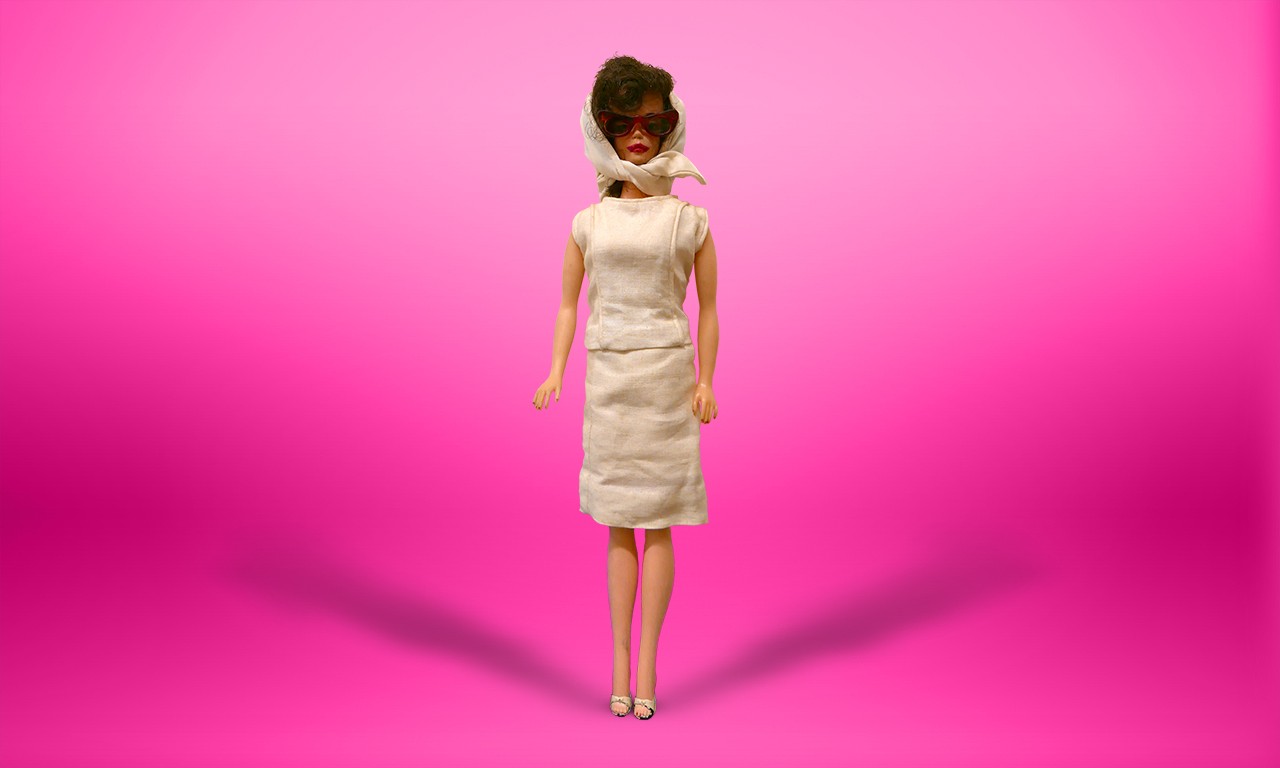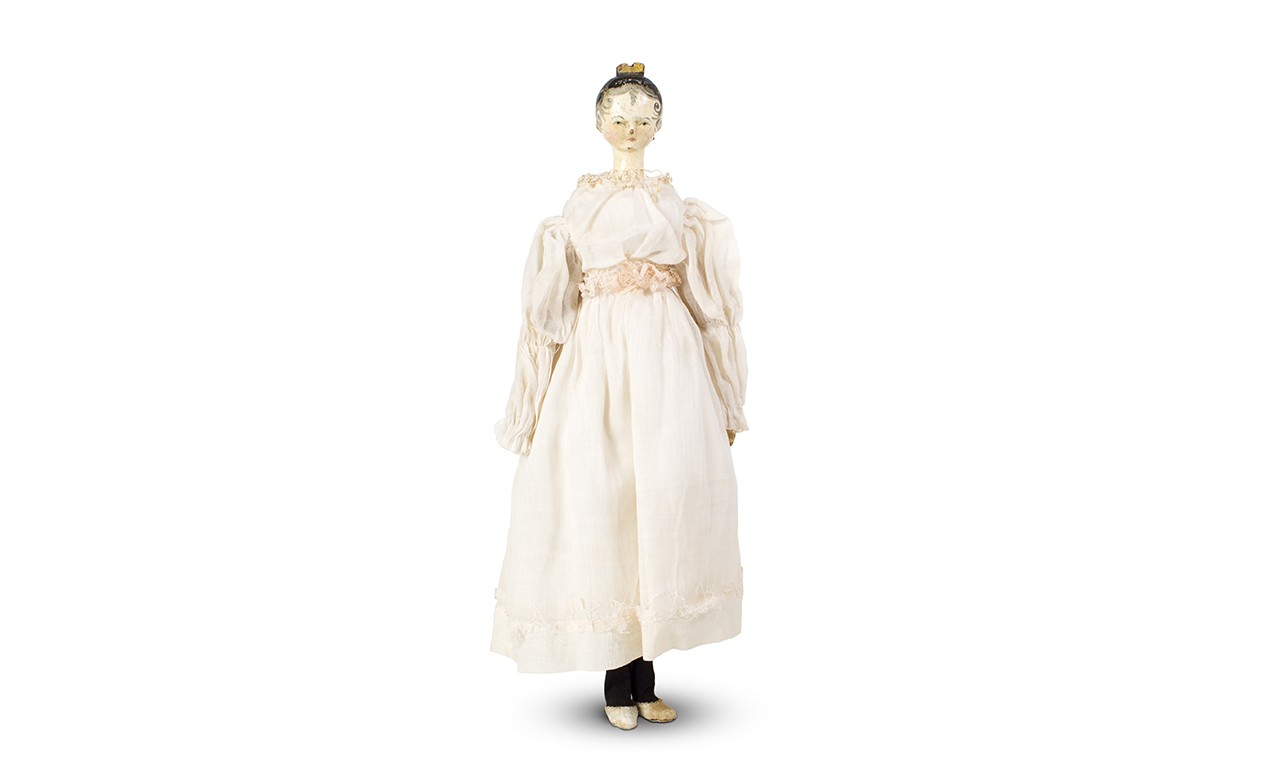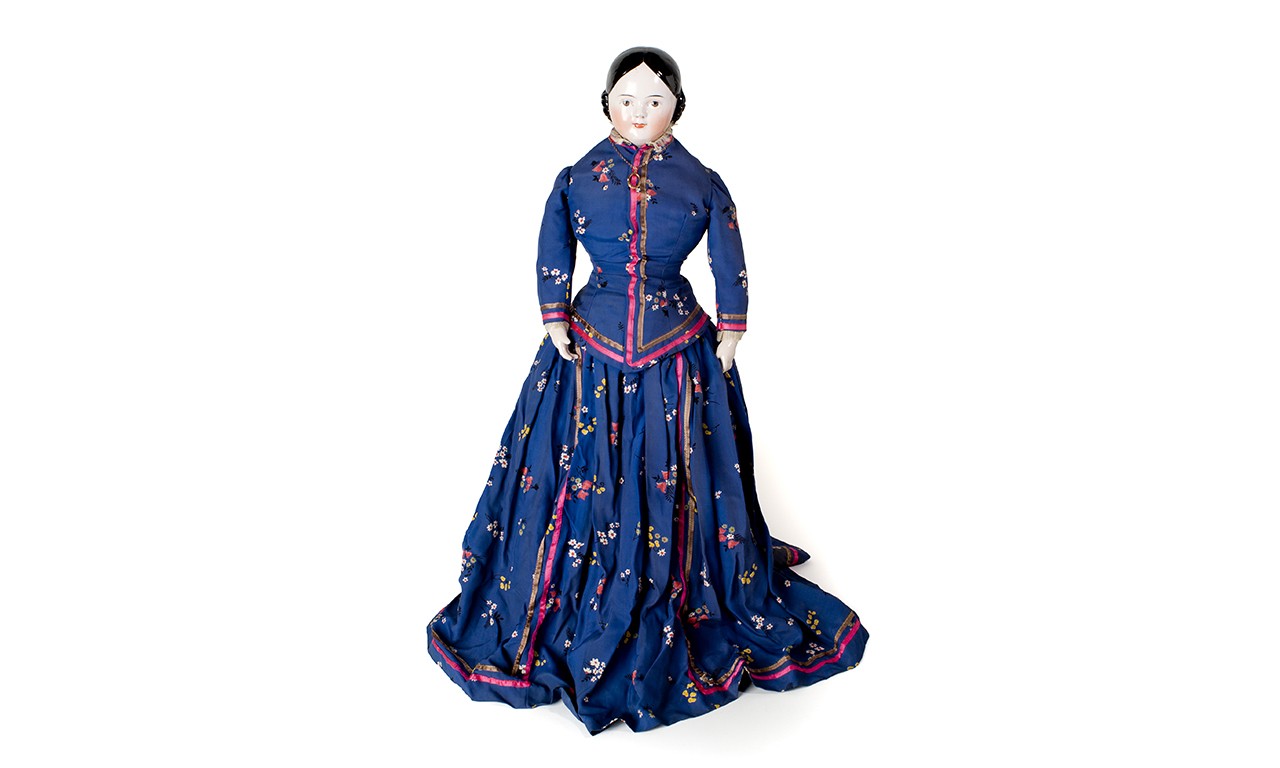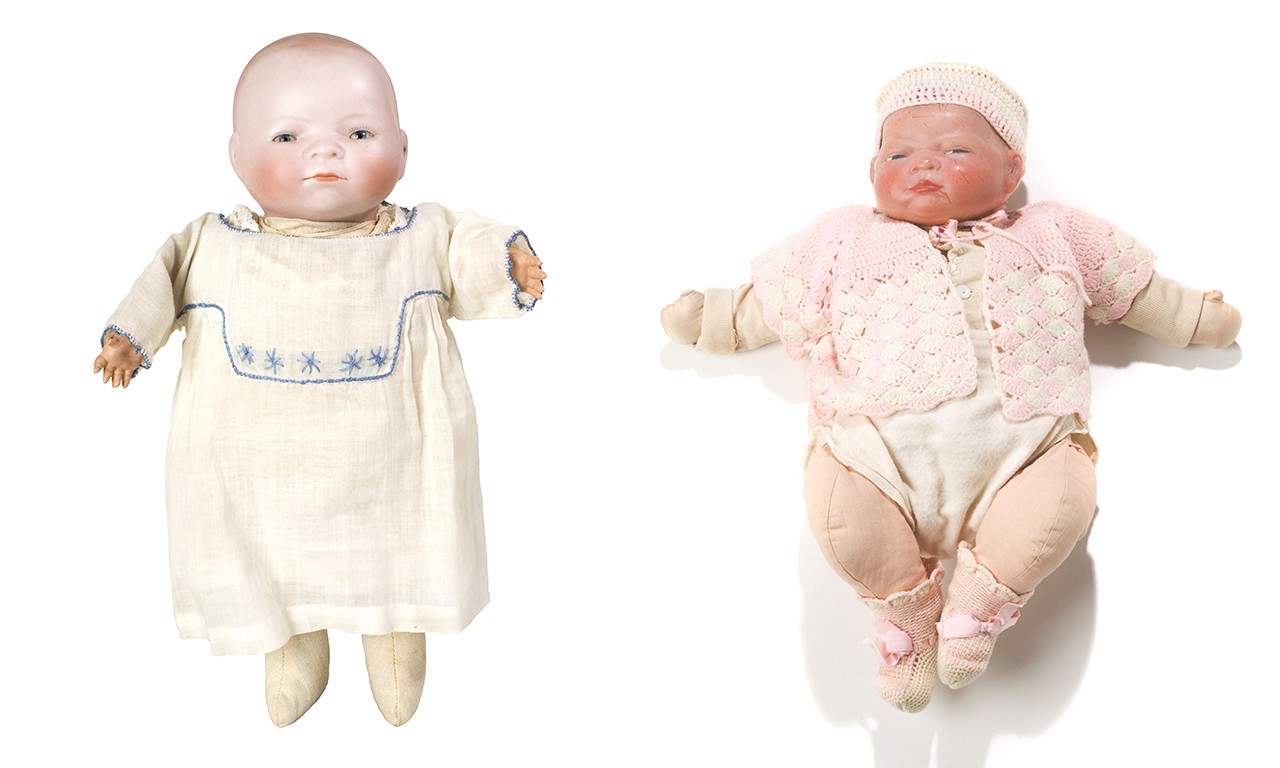 |
Jacqueline Kennedy Mitzi Doll, 1960-1962
Ideal Toy Company (1907-1997); Hollis, Queens, New York
Plastic, paint, and fabric; 11 ½ in.
37944
Gift of Mrs. Lilian Norman Gally |
Doling out Doll Facts
Barbie (2023) has driven its dream car past a biopic on the father of thermonuclear weapons to become this summer’s biggest blockbuster film. While dolls take a backseat to an exploration of what it means to be a woman in our modern, mostly patriarchal world, the film nonetheless features anthropoid toys in a big way—especially as it opens with a note on the first dolls ever to be made. Today’s Bowers Blog post skirts around the most important themes of the film to look at a selection of the 1,700 dolls in our permanent collection that either preceded or sought to compete with Barbie dolls.
 |
Tuck-Comb Doll, c. 1830
Unknown maker; Germany
Wood, organdy, wire, silk and hair; 15 1/2 × 5 1/2 × 3 in.
86.17.2
Gift of Julia Rounds Colborn and Chase Charles Colborn |
Mortise and the Hair
The very earliest dolls ever made appear to date at least as far back as 2,200 BCE in ancient Egypt, but it is this tuck-comb doll made around 1830 in Germany that can boast the distinction of being one of the Bowers’ older European-style dolls. The unique name is unsurprisingly attributed to the small wooden comb that is tucked into doll's hair. Broadly speaking, this is a peg wooden doll, a type which was primarily made from the early 18th century to the 19th century and named for the mortise and tenon peg joints connecting its limbs. They are usually made entirely of wood, although some mid-19th century doll heads were made of porcelain or composition—a mixture of mediums such as sawdust, glue, and other materials such as cornstarch, and resin. Her black hair, painted on with extremely delicate brush marks, illustrates the residual influence of extremely severe hair styles of the early 1800s, but is softened around the face with additional light grey wisps of hair and "spit curls." The condition of the doll’s white satin dress compared against the wear of the doll itself indicates that it was made significantly later.

 |
Covered Wagon Hair Doll, c. 1840
Unknown maker; Germany
China, lace, and cotton; 28 × 15 × 12 in.
7864
Irene P. Cutter Memorial Doll Collection |
Oregon Hale
This rare American-colonial-style doll, also hailing from Germany, was made about a decade after the tuck-comb doll featured above. Its head, hands, and feet are made of a type of porcelain called "pink lustre" and her face is delicately painted with fine detailing. The coiffure on this doll is frequently called a "Covered Wagon" hairstyle, which represents the needs of colonial American women for simple styles which were compatible with the activities of everyday life. Her blue silk floral dress with coral trim is also reflective of colonial American women’s style during this time period. What the image of this doll fails to capture is its scale, at more than two feet tall, this doll is the same height as a year-old infant.

 |
Composition Doll, c. 1906
Unknown maker; dressed by Madame Helena Modjeska Chlapowska (Polish-born American, 1840-1909); Made in Germany; Dressed in California
Composite material, cotton, leather, synthetic diamonds, and glass beads; 28 in.
35818
Gift of Mr. and Mrs. J. Robert Paine |
All The World’s A Dollhouse
Orange County’s most famous Polish thespian, Madame Helena Modjeska, was very enamored by dolls. Though she did not create this composition doll, the body is marked on the rear of its head as having been made in Germany, Modjeska made its dress from the fabrics in her own wardrobe—the same materials that she used in creating her stage costumes. According to a news clipping, she prepared the doll for 1906 for a fair held at a local Catholic church. The woman who won the doll as a prize gave it to her daughter before ultimately donating it to the Bowers 1941.
 |
Bye-Lo Baby Doll, 1920-1940
Grace Storey Putnam (American, 1877-1947); Germany
Ceramic, paint and cotton; 10 1/4 × 3 1/4 × 7 3/4 in.
76.5.1
Gift of Mrs. Elizabeth Lyser Powers |
Bye-Lo Baby Doll, c. 1924
Grace Storey Putnam (American, 1877-1947); Los Angeles, California
Cotton, wax and oil paint; 18 × 12 × 6 in.
35310
Gift of Mr. George Putnam |
Bye-Lo, Sell High
The mass-production of dolls coincided with the advent of the first baby dolls in the latter half of the 19th century. Previously, dolls had with few exceptions always depicted adults. The new trend, fueled in part by an interest in dolls doubling as tools for teaching young girls how to nurture babies, took the industry by storm, with doll designers setting their dolls apart by any means possible including the incorporation of mechanized parts to inadvertently terrifying effect. The Bye-Lo was designed by Grace Storey Putnam who desired to create a doll which was as life-like as possible. In 1920 Putnam visited the Salvation Army day nursery in Los Angeles where she studied a three-day old sleeping girl. Using clay, she quickly worked at the baby’s side to sculpt its likeness. It is said that when she returned to the hospital with the finished the wax model and laid it beside the baby the onlookers could hardly tell which was the live baby and which was the doll. The dolls were a huge success, earning the nickname "million-dollar babies." The Bye-Lo above on the left was given directly to the mother of the donor by Putnam. Several other dolls and doll parts in the Bowers collections were donated directly by Putnam through a friendship with the Bowers’ first Curator and doll-enthusiast Bessie Beth Coulter.

Mitzi
Though the first Barbie dolls created in 1959 were based upon a farcical doll that was sold in Europe, the repackaging and advertising of the fashion figure to young women in the United States marked a pivotal moment in the history of dolls. Just as the Bye-Lo before it, the success of Barbie spawned a great many imitations including the Mitzi series from Ideal Toy Company. This particular model is of First Lady Jacqueline Kennedy—a paragon of fashion in her time—wearing a two-piece sport dress, head scarf, and sunglasses. The limited comparative success of most Barbie knock-offs led to them being relatively short-lived, and that was the case with Mitzi. She was discontinued just two years after hitting shelves in favor of Ideal Toy Company’s new Tammy line which itself only lasted until 1966. If the history of dolls is indicative of anything, it is that design preferences have been in near-constant flux. Taking advantage of its initial success, Barbie as a brand has largely dodged criticism and remained relevant by adapting to the changing interests and concerns of women.
Text and images may be under copyright. Please contact Collection Department for permission to use. Information subject to change upon further research.






Comments 1
You have so many wonderful, interesting collections!